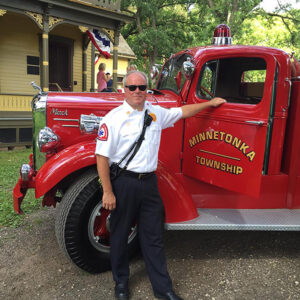Ask the Chiefs: Real Leaders Harness Team Strengths & Trust Their Experience
April 28, 2025Ask the Chiefs
Real Leaders Harness the Team's Strengths & Trust Their Experience
By Terry Garrison & John Vance
B Shifter Buckslip, April 29, 2025
Dear Chiefs,
As a new fire officer, how can I avoid the mistakes of both oversupervising and underutilizing my crew? How can I identify and utilize their existing motivations and experiences—such as their upbringing, military background or prior training—that influence their actions, rather than assuming my leadership is their primary driver?
Signed,
Learning to Lead
Let me share a true story that occurred when I was a fire captain temporarily assigned to an engine company near downtown Phoenix. I was on overtime, and it was my first time working with this crew. We received a call for a motor vehicle accident on one of our busier roads, and when we arrived, we learned that a truck pulling a horse trailer was involved in the MVA. Luckily, there were no injuries to the people involved. However, the single-horse trailer was now on its side in the middle of the road—a serious problem, as a horse was trapped inside and kicking like hell, wanting very badly to get out of there. My only experience with anything country was owning a pair of boots and a cowboy hat, which I proudly wore to our local country bars. (In Texas, they refer to this as, “Big hat, no cattle.”) Undoubtedly, the horse was struggling and would soon hurt itself if not freed from his current position.
I quickly accessed the situation and tried to determine which agency to call for help when the engineer assigned to our engine crew confidentiality stated that he could get the horse out. You see, he was a real cowboy, born and raised, while I just played one on Saturday nights. As I, five other firefighters, a dozen cops and countless citizens watched in amazement, he and the horse’s owner were able to calm him down and somehow got him out of the trailer and back on his feet. (Yeehaw! Horse whisperers do exist.)
Some of you reading this might think the risk was too high and this isn’t the job we signed up for. I understand your concern. Trust me, all of that went through my head, but I believed in and trusted our cowboy firefighter. If necessary, I knew I could call the whole thing off. However, the horse’s life was in jeopardy, and we needed to try at least to save him. There was actually a conversation among the cops regarding which one of them would shoot the horse and put him out of his misery. I was hoping that was not going to be our plan B.
This story is an extreme example of how firefighters come with different expertise and unique experiences. I have witnessed many instances where a firefighter has solved our customer’s problems using their personal skills: plumbers, electricians, contractors, foreign language speakers, American Sign Language interpreters, and yes, cowboys. Sometimes, the military veterans and women on our crews can connect with our customers in ways others cannot. This is the strength of diversity: Bringing together people with different experiences and working as a team to solve our customers’ problems. Bruno used to say, “If you are the smartest person in the room, find another room.” He was speaking directly to leaders (supervisors, fire captains, command officers and fire chiefs), emphasizing that every team member brings value, and no one person has all the answers, regardless of rank. The most successful leaders listen, learn and grow from input and feedback they receive from their team.
The key to becoming a successful leader is through influence—the capacity to affect another’s character, development or behavior. Influence does not occur without trust...
Amazing things get done when we put our egos aside and focus on the work. Of course, no one questions that leaders need to play their role and remain in charge. However, it is how they play their role that matters. The hazard zone is autocratic, and the one-boss principle works best. That is why we identify a single IC. But outside the hazard zone, we have more discretionary time, and gathering input from team members makes sense when reasonable. In fact, a great trust-building and teaching exercise is to ask members what they think as a way of educating them. Take the time to listen and point out the facts when you disagree. I have always told my young firefighters to consider what they would do on an incident. The first time a firefighter thinks about making critical decisions shouldn’t be after they’ve earned their captain’s badge.
The key to successful leadership is to focus on the work. We train firefighters to perform and deliver our core services so everyone has the same level of skill and competence. Added value comes into play when we use our unique perspectives to create the best customer outcomes. I remember one heartbreaking call when a woman was gang-raped (it feels uncomfortable even to say it, but it happened), and the police could not get her to move from the basement where the assault occurred. It was not until our female firefighter spoke with her that she allowed us to place her in the ambulance. Most calls are not this extreme, but allowing firefighters to contribute their unique attributes can have a significant impact.
In your question, you mentioned influence. I think you’ve hit the role of leader on the head. The key to becoming a successful leader is through influence—the capacity to affect another’s character, development or behavior. Influence does not occur without trust, and remembering that trust must go both ways. When you trust your firefighters, they will trust you. Leaders who bully (micromanage) or demean (underutilize and dismiss) their workers always seem to wonder why their crew members act disrespectfully. The simple answer is that they don’t trust them. These leaders use their positional power and ignore their personal power. The more a leader relies on their positional power, the more they lose their personal power. Personal power is based on relationships with others; I have never seen a leader who is a team of one.
It seems like you are on the right track. By simply identifying the problems that some leaders have and recognizing that each firefighter brings their own unique strengths to the team, you are starting on the right path. Thank you for reaching out to B Shifter, and good luck!
—Terry Garrison
Finding the balance between providing leadership and avoiding over-supervision is critical to building a strong, effective team. It will also affect your reputation in the organization. Word gets out quickly who the micromanagers are, and guess what? Nobody wants to work for them! The transition from firefighter to fire officer can be challenging, as it often involves shifting from being part of the crew to leading it. One of the most common pitfalls for new officers is the temptation to over-supervise, which can stifle initiative and undermine trust. Consider the following strategies to avoid this mistake and leverage your crew’s motivations and experiences.
1. Embrace Humility & Active Listening
One of the first steps to avoid micromanaging is to approach your new role humbly. Recognize that your crew members bring valuable skills, knowledge and experiences to the table. Whether it’s a veteran firefighter with decades of experience, a former military service member with strong discipline and structure, or a new recruit with fresh training perspectives, each individual has something to contribute.
Engage in active listening by asking open-ended questions and genuinely considering their input. Bruno would often do this, and we would refer to it as breadcrumb management. Leading your crew to find their own answers to dilemmas is more meaningful and has a lasting result.
When you make decisions, especially those affecting the whole crew, explain your thought process and invite feedback. This not only builds trust but also demonstrates respect for their expertise and opinions.
2. Delegate with Purpose
Effective delegation is not about offloading tasks but rather about empowering your crew. Assign responsibilities based on individual strengths and experiences. For example, a crew member with a military background might excel in roles requiring structure and discipline. If a crew member possesses technical prowess, they could assist by leveraging the latest technology for learning and being more efficient.
When delegating, be clear about expectations and outcomes, but avoid micromanaging the process. Give your team the autonomy to approach tasks in their own way and be available for guidance rather than control. This approach enhances efficiency and fosters a sense of ownership and accountability.
Engage in active listening by asking open-ended questions and genuinely considering their input. Bruno would often do this, and we would refer to it as breadcrumb management. Leading your crew to find their own answers to dilemmas is more meaningful and has a lasting result.
When you make decisions, especially those affecting the whole crew, explain your thought process and invite feedback. This not only builds trust but also demonstrates respect for their expertise and opinions.
3. Recognize & Adapt to Different Motivations
Every firefighter has unique motivations, and recognizing these can help you lead more effectively. Some might be motivated by a sense of duty and tradition, others by career advancement and some by the camaraderie of the firehouse environment.
Take time to understand what drives each member of your crew. Informal conversations, mentorship sessions and observation during drills and downtime can provide insights. Use this knowledge to align tasks and roles with their motivations. For example, if a firefighter thrives on teaching, involve them in training programs. If another finds fulfillment in problem-solving, engage them in planning and logistics.
4. Provide Constructive Feedback & Celebrate Successes
Feedback is a powerful tool when used correctly. Instead of waiting for formal reviews, offer constructive feedback regularly. Highlight what is going well and provide guidance on what can be improved. When mistakes happen, approach them as learning opportunities rather than failures.
Equally important is recognizing and celebrating successes. Whether it’s a job well done on a call, initiative shown during training, or a positive contribution to the firehouse culture, acknowledgment and positive reinforcement go a long way in building morale and influencing desired behaviors.
5. Lead by Example
Your actions set the tone for your crew. Demonstrate the standards you expect through your own behavior, whether it’s showing up early, maintaining a positive attitude, or continually pursuing education and training. When your team sees you living the values you promote, they are more likely to mirror those behaviors.
6. Build Trust Through Consistency & Fairness
Consistency and fairness are foundational to building trust. Avoid favoritism and ensure that rules and expectations apply equally to all. When your crew knows you are fair and consistent, they are more likely to respect your authority and follow your lead.
7. Promote a Culture of Continuous Learning
Encourage your crew to pursue training and development opportunities. Create an environment where asking questions and seeking knowledge is valued. When firefighters feel supported in their professional growth, they are more likely to bring fresh ideas and a proactive mindset to the team.
8. Avoid “Front & Centerist” Behavior
Another bad boss behavior Bruno would call out is the need for a leader to always be front and center. Often, this happens because the leader thinks this is their job or their ego loses all sense of self-control because they get a new bugle on their collar. Be there when they need you, and forget the need to be the focal point of all activities!
Lead the Team, Trust the Talent
As a new fire officer, your leadership is important, but it is not the sole force that drives your crew’s performance. By avoiding the trap of over-supervision and tapping into your team’s diverse experiences and motivations, you can create a balanced, dynamic and effective crew. Embrace humility, delegate wisely and provide thoughtful feedback. Most importantly, trust your team to rise to the occasion. By doing so, you not only enhance operational performance but also build a resilient and motivated firehouse culture.
—John Vance

John Vance recently retired as a fire chief after 22 years in the front office. He is currently a battalion chief with the Chanhassen (Minn.) Fire Department; he has been a chief officer since 2002. He is a proud Blue Card lead instructor and an accredited chief officer through the Center for Public Safety Excellence. John has a bachelor’s degree in fire service management from Southern Illinois University and a certificate in executive management from the University of Notre Dame. He is the host of the B Shifter Podcast.

In 2007, Terry Garrison retired from the Phoenix Fire Department after serving more than 30 years. Working for Alan Brunacini and reaching the rank of assistant chief of operations helped shape Terry’s consistent values: firefighter safety and customer service. After a quick retirement, Terry served as the fire chief of the Oceanside (Calif.) Fire Department for almost three years. He then served as the chief of the Houston Fire Department for more than five years. Terry eventually moved back to where he was raised and served as the fire chief for the Glendale (Ariz.) Fire Department for more than six years before officially retiring from government service. Including his two years in the U.S. Army, Terry has worked for the government and worn a nametag and a helmet for more than 47 years. (Thank goodness for helmets.) In addition, he has traveled throughout the world teaching Fire Command, utilizing his master’s degree in education. Today, Terry and his wife, Annette, live in Phoenix. He will continue to stay connected to the fire service by working with B Shifter.



